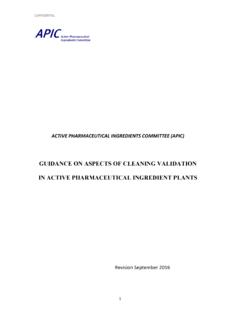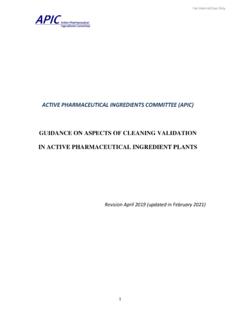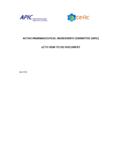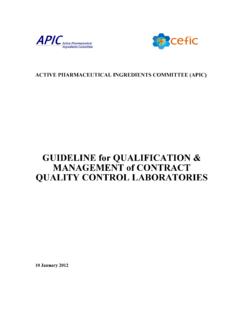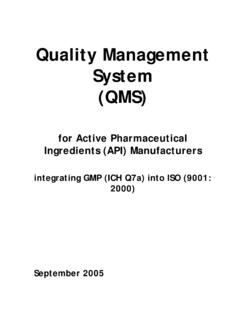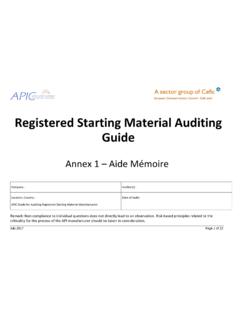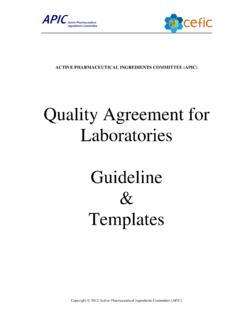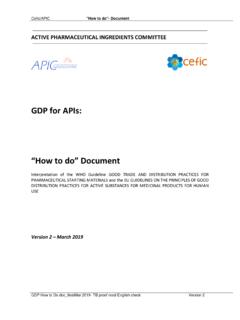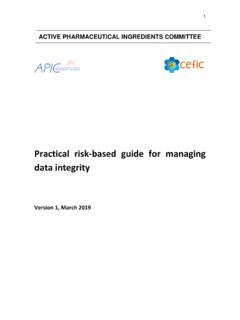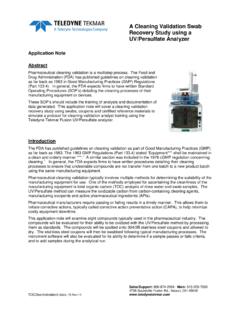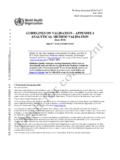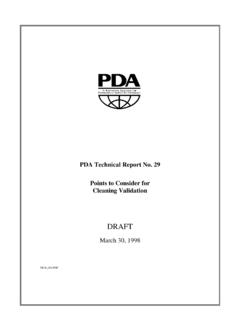Transcription of Guidance on aspects of cleaning validation in active ...
1 Guidance on aspects of cleaning validation in active pharmaceutical ingredient plants December 2000A Sector Group of CEFICC leaning validation Guidance 1 Table of Contents FOREWORD 3 OBJECTIVE 3 SCOPE 3 ACCEPTANCE CRITERIA 4 Introduction 4 Methods of Calculating Acceptance Criteria 4 Based on Therapeutic Daily Dose 4 Based on Toxicological Data 6 General Limit 7 Swab Limits 9 Rinse Limits 14 LEVELS OF cleaning 16 Introduction 16 Procedure 16 BRACKETING
2 AND WORST CASE RATING 20 Introduction 20 Bracketing Procedure 20 cleaning Procedures 22 Investigations and Worst Case Rating (WCR) 23 Worst Case Rating 26 DETERMINATION OF THE AMOUNT OF RESIDUE 30 Introduction 30 validation Requirements 30 cleaning validation Guidance Sampling Methods 37 Analytical Methods 39 cleaning validation PROTOCOL 40 Background 41 Purpose 41 Scope 41 Responsibility 42 Sampling Procedure 42 Testing procedure 43 Acceptance criteria 44 Deviations from protocol 46 validation QUESTIONS 47 REFERENCES 53
3 GLOSSARY 54 COPYRIGHT AND DISCLAIMER 55 cleaning validation Guidance Foreword This document has been prepared by the cleaning validation task force within the active pharmaceutical ingredient committee (APIC) of CEFIC. In recent years the subject of cleaning validation in active pharmaceutical ingredient manufacturing plants has received a large amount of attention from regulators, companies and customers alike. It is important that the requirements for the finished manufacturing companies are not transferred back in the process to active pharmaceutical ingredient manufacturers without consideration for the different processes that take place at this stage.
4 The document reflects the outcome of discussions between APIC member companies on how cleaning validation requirements could be fulfilled and implemented as part of routine operations. It should be read in conjunction with the APIC document entitled cleaning validation in active Pharmaceutical Ingredient Manufacturing Plants Objective This document has been prepared only to assist companies in the formulation of cleaning validation programmes and should not be considered a technical standard but a starting point for internal discussions. The document includes examples on how member companies have dealt with specific areas and issues that arise when performing cleaning validation . Scope Five specific areas are addressed in this Guidance document, namely: Acceptance Criteria Levels of cleaning Bracketing and Worst Case Rating Determination of the amount of residue cleaning validation Protocol Finally the most frequently asked questions are answered.
5 cleaning validation Guidance Acceptance Criteria Introduction Companies must demonstrate during validation that the cleaning procedure routinely employed for a piece of equipment limits potential carryover to an acceptable level. That limit established must be calculated based on sound scientific rational. This section provides practical Guidance as to how that acceptance criteria can be calculated. It is important that companies evaluate all cases individually. There may be specific instances where the product mix in the equipment require further consideration. Methods of Calculating Acceptance Criteria Based on Therapeutic Daily Dose The principle for the requirement is that the standard Therapeutic Daily Dose (TDD) of the following substance ( contaminated substance, in this case called "next") may be contaminated by no more than a certain proportion (usually 1/1000 part) of the TDD of the substance investigated in the cleaning validation (contaminating substance, in this case called "previous").
6 This method only applies when the therapeutic daily dose is known. It is generally used for final product changeover API Process A to API Process B. Procedure Establish the limit for Maximum Allowable Carryover (MACO) according to the following equation. TDDprevious x MBS MACO = ------------------------------ SF x TDDnext MACO Maximum Allowable Carryover: acceptable transferred amount from the investigated product ("previous") TDDprevious Standard therapeutic dose of the investigated product (in the same dosage form as TDDnext) TDDnext Standard therapeutic dose of the daily dose for the next product MBS Minimum batch size for the next product(s) (where MACO can end up) SF Safety factor (normally 1000 is used in calculations based on TDD) cleaning validation Guidance 5 Example 1: Product A will be cleaned out. The product has a standard daily dose of 10 mg and the batch size is 200 kg. The next product B has standard a daily dose of 250 mg and the batch size is 50 kg.
7 Both A and B are administrated orally and SF is set to 1000. Calculate the MACO for A in B! 10 (mg) x 50 000 000 (mg) MACO = ------------------------------------ = 2 000 (mg) 1000 x 250 (mg) Result: MACO is 2 g (2000 mg) Example 2: Now product B in example 1 will be cleaned out. The following product is product A in example 1. Calculate the MACO for B in A! 250 (mg) x 200 000 000 (mg) MACO = ---------------------------------------- = 5 000 000 (mg) 1000 x 10 (mg) Result: MACO is 5 kg (5 000 000 mg) In API manufacture it is possible to obtain a very high MACO figure. In example 2, the figure obtained is clearly unacceptable. Although there would be no effects expected, the equipment would be obviously dirty and a general GMP limit should be chosen (see - page 7 - how to select limits). Instead of calculating each potential product change situation, the worst case scenario can be chosen. Then a case with most active API (lowest TDD) is chosen to end up in the following API with the smallest ratio of batch size divided with TDD (MBS/TDD ratio).
8 This could be done if the safety factor is the same for all products (otherwise the lowest MBS/(TDDxSF) ratio should be chosen). cleaning validation Guidance Based on Toxicological Data In cases in which a therapeutic dose is not known ( for intermediates and detergents), toxicity data may be used for calculating MACO. Procedure Calculate the so called NOEL number (No Observable Effect Level) according to the following equation and use the result for the establishment of MACO. (See [3] page 53 - for reference.) LD50 (g/kg) x 70 (kg a person) NOEL = ---------------------------------------- - 2000 From the NOEL number a MACO can then be calculated according to: NOEL x MBS MACO = ------------------------------ SF x TDDnext MACO Maximum Allowable Carryover: acceptable transferred amount from the investigated product ("previous") NOEL No Observed Effect Level LD50 Lethal Dose 50 in g/kg animal. The identification of the animal (mouse, rat etc.)
9 And the way of entry (IV, oral etc.) is important. 70 kg 70 kg is the weight of an average adult 2000 2000 is an empirical constant TDDnext Largest normal daily dose for the next product MBS Minimum batch size for the next product(s) (where MACO can end up) SF Safety factor The safety factor (SF) varies depending on the route of administration. Generally a factor of 200 is employed when manufacturing APIs to be administered in oral dosage forms. SF can vary depending on substance/dosage form according to (suppose tox values from oral administration) as for example as presented on the next page. cleaning validation Guidance 7 Safety factors: Topicals 10 100 Oral products 100 1000 Parenterals 1000 10 000 Remarks: API`s in development may require higher safety factors due to lack of knowledge. To calculate MACO values from tox data is frequently done when therapeutic dosage data is not available or not relevant.
10 It is generally employed if the previous product is an intermediate and the following product an API. General Limit If the calculation methods based on therapeutic doses or toxicological data (see or , page 4 7) result in unacceptably high or irrelevant carryover figures, or toxicological data for intermediates are not known, the approach of a general limit may be suitable. Companies may chose to have such an upper limit as a policy. The general limit is often set as an upper limit for the maximum concentration (MAXCONC) of a contaminating substance in a subsequent batch. The concentration (CONC) of the investigated substance which can be accepted in the next batch, according to dose related calculations, is: MACO CONC = ------------------------------ MBS MACO Maximum Allowable Carryover: acceptable transferred amount from the investigated product ("previous").
